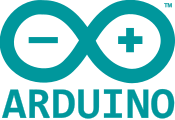| Line 1: | Line 1: | ||
{{stub}} | {{stub}} | ||
| + | [[File:Arduino Logo.svg|175px|right]] | ||
An '''Arduino''' is an [[evaluation kit]]-like single-board, microcontroller intended for hobbyists by making electronic projects easier and more accessible.<ref>[http://arduino.cc/ Arduino] accessed on December 22, 2013</ref> The Arduino is an open-source hardware project that use 8-bit to 32-bit processors. The Arduino has a [[C]] compiler with a set of [[Arduino standard libraries|standard libraries]] that provide easy functionality for performing common tasks such as setting up interrupts, reading I/O pins, setting up [[PWM]] pins, reading and writing to the [[EEPROM]], and various other services. A major reason for the Arduino's popularity steams from its easy way of interfacing with an extensive set of sensors, motors, and other modules (called '[[shields - Arduino|shields]]'). | An '''Arduino''' is an [[evaluation kit]]-like single-board, microcontroller intended for hobbyists by making electronic projects easier and more accessible.<ref>[http://arduino.cc/ Arduino] accessed on December 22, 2013</ref> The Arduino is an open-source hardware project that use 8-bit to 32-bit processors. The Arduino has a [[C]] compiler with a set of [[Arduino standard libraries|standard libraries]] that provide easy functionality for performing common tasks such as setting up interrupts, reading I/O pins, setting up [[PWM]] pins, reading and writing to the [[EEPROM]], and various other services. A major reason for the Arduino's popularity steams from its easy way of interfacing with an extensive set of sensors, motors, and other modules (called '[[shields - Arduino|shields]]'). | ||
| Line 5: | Line 6: | ||
== History == | == History == | ||
| + | [[File:A hand-soldered Arduino.jpg|thumb|right|250px|A hand-soldered Arduino board]] | ||
The original project started in 2002 when Massimo Banzi was brought into [[Wikipedia:Interaction Design Institute Ivrea|IDII]].<ref>[http://spectrum.ieee.org/geek-life/hands-on/the-making-of-arduino IEEE Spectrum], accessed on December 24, 2013</ref> Unfortunately their dwindling budget caused them to look for alternative means of doing interactive design. At the time, students relied on the [[BASIC Stamp]], another microcontroller designed by [[Parallax] which can be programmed in [[BASIC]] and has been used in the field for over a decade. Their major issue with that board was that it was relatively expensive (around $100 per board) and it lacked the processing power needed for some of his student's projects. | The original project started in 2002 when Massimo Banzi was brought into [[Wikipedia:Interaction Design Institute Ivrea|IDII]].<ref>[http://spectrum.ieee.org/geek-life/hands-on/the-making-of-arduino IEEE Spectrum], accessed on December 24, 2013</ref> Unfortunately their dwindling budget caused them to look for alternative means of doing interactive design. At the time, students relied on the [[BASIC Stamp]], another microcontroller designed by [[Parallax] which can be programmed in [[BASIC]] and has been used in the field for over a decade. Their major issue with that board was that it was relatively expensive (around $100 per board) and it lacked the processing power needed for some of his student's projects. | ||
Revision as of 21:02, 24 December 2013
| This article is still a stub and needs your attention. You can help improve this article by editing this page and adding the missing information. |
An Arduino is an evaluation kit-like single-board, microcontroller intended for hobbyists by making electronic projects easier and more accessible.[1] The Arduino is an open-source hardware project that use 8-bit to 32-bit processors. The Arduino has a C compiler with a set of standard libraries that provide easy functionality for performing common tasks such as setting up interrupts, reading I/O pins, setting up PWM pins, reading and writing to the EEPROM, and various other services. A major reason for the Arduino's popularity steams from its easy way of interfacing with an extensive set of sensors, motors, and other modules (called 'shields').
Arduino board are an open specification. They can be bought pre-assembled, as a DIY kits, or in individual parts to be assembled by hand.
History
The original project started in 2002 when Massimo Banzi was brought into IDII.[2] Unfortunately their dwindling budget caused them to look for alternative means of doing interactive design. At the time, students relied on the BASIC Stamp, another microcontroller designed by [[Parallax] which can be programmed in BASIC and has been used in the field for over a decade. Their major issue with that board was that it was relatively expensive (around $100 per board) and it lacked the processing power needed for some of his student's projects.
After seeing the success of the processing programming language developed by his colleague from MIT which was due to its simplicity of use, Banzi wondered if the same concept can be applied for a microcontroller.
The first prototypes were done using Wiring, programming framework for microcontrollers which was developed at the same school in 2003.[3] From there they fine-tuned it, making it cheaper and lighter. Additionally, their microcontroller was accommodated by an IDE. The first prototype board was released in 2005. The same year the board got its name: the Arduino.[4] The Arduino was released under Creative Commons Attribution Share-Alike license. Today, the Arduino can be bought from as low as $10-$30.

